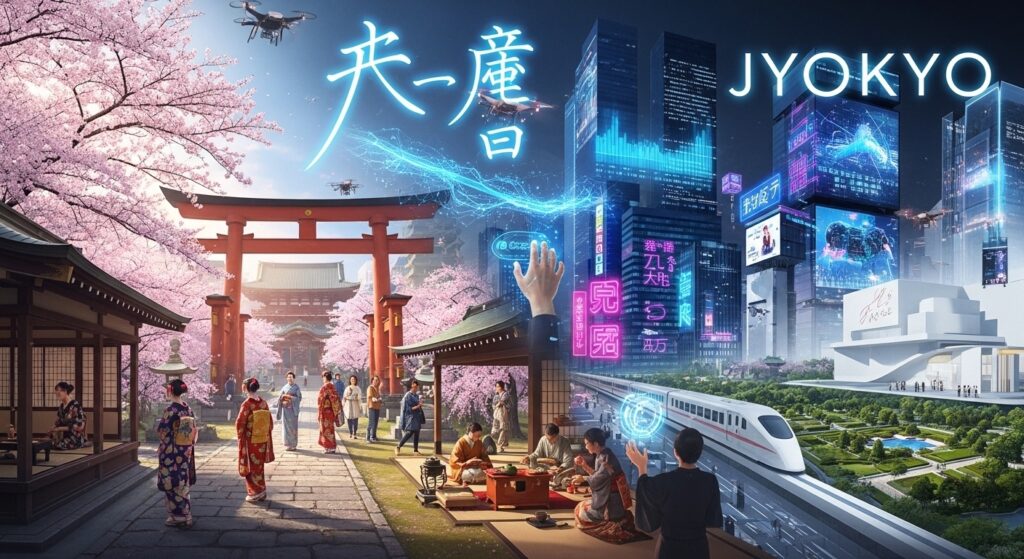The Japanese language contains thousands of words that don’t have direct English translations, each carrying layers of cultural meaning and historical context. Among these fascinating terms is “jyokyo” (状況), a word that has evolved from its traditional roots to find new relevance in our digital age. While it might seem like just another vocabulary word to learn, jyokyo represents something much deeper—a way of understanding and describing the complex situations that shape our daily lives.
Whether you’re a Japanese language learner, a cultural enthusiast, or someone curious about how words travel across cultures, understanding jyokyo offers valuable insights into Japanese thinking and communication patterns. This exploration will take you through the word’s origins, its various applications, and how it continues to evolve in contemporary usage.
The term has particular significance because it demonstrates how Japanese culture approaches the concept of situational awareness—something that has become increasingly important in our interconnected world.
The Traditional Roots of Jyokyo
Jyokyo (状況) is composed of two kanji characters that together create a meaning greater than the sum of their parts. The first character, 状 (jyo), relates to condition or state, while 況 (kyo) refers to circumstances or situation. This combination gives us a word that encompasses both the immediate conditions of a situation and the broader circumstances surrounding it.
Historically, jyokyo has been used in formal contexts to describe complex situations that require careful consideration. Unlike simpler words for “situation” in Japanese, jyokyo carries an implied weight—it suggests circumstances that are significant, often challenging, and worthy of serious attention.
The word appears frequently in classical Japanese literature and formal documents, where it often describes political situations, social conditions, or personal circumstances that have far-reaching implications. This formal tone has persisted even as the word has found broader usage in modern Japanese.
Modern Applications and Usage
The contemporary use of jyokyo has expanded well beyond its traditional boundaries. You’ll encounter this word in news broadcasts, business meetings, casual conversations, and digital communications. Its versatility makes it particularly useful for describing the complex, multi-layered situations that characterize modern life.
Business and Professional Settings
In corporate environments, jyokyo frequently appears in discussions about market conditions, project status updates, and strategic planning. Japanese business culture values thorough situational analysis, and jyokyo serves as the linguistic vehicle for these detailed assessments.
For example, a project manager might describe the “genzai no jyokyo” (current situation) when presenting to stakeholders, encompassing not just immediate project status but also external factors affecting progress. This usage reflects the Japanese business approach of considering multiple variables when making decisions.
News and Media
Japanese media outlets rely heavily on jyokyo when reporting on complex stories. Political developments, economic trends, and social issues are often framed as evolving jyokyo that require ongoing attention and analysis. This linguistic choice signals to readers that the situation is serious and multifaceted.
The word’s presence in headlines and news reports has helped cement its place in contemporary Japanese vocabulary, making it familiar to speakers across all age groups and social backgrounds.
Digital Age Evolution
The internet and social media have given jyokyo new life and new meanings. Online discussions frequently use the term to describe everything from gaming scenarios to relationship dynamics, demonstrating the word’s adaptability to digital communication styles.
Social Media and Online Communities
On platforms like Twitter, Instagram, and Japanese forums, jyokyo has become a way to quickly communicate that a situation is complex or noteworthy. Users might hashtag #現在の状況 (genzai no jyokyo – current situation) when sharing updates about ongoing events in their lives.
This digital usage often carries a slightly different tone than traditional applications. While maintaining some formality, online jyokyo can also convey irony, frustration, or humor, depending on context.
Gaming and Entertainment
The gaming community has particularly embraced jyokyo’s as a way to describe in-game situations, strategic positions, or competitive scenarios. This usage has helped introduce the word to younger generations who might not encounter it in traditional contexts.
Cultural Significance and Worldview
Understanding jyokyo’s provides insights into Japanese cultural attitudes toward complexity and nuance. The word reflects a worldview that recognizes situations are rarely simple or straightforward—they exist within webs of interconnected circumstances that require careful consideration.
This perspective aligns with broader Japanese cultural values such as reading the air (kuuki wo yomu) and understanding context (kontekusuto wo rikai suru). Jyokyo serves as a linguistic tool for navigating these culturally important concepts.
Comparison with Western Concepts
While English has words like “situation,” “circumstances,” and “conditions,” none carry quite the same weight or formality as jyokyo’s . This difference highlights how language shapes our understanding of complexity and seriousness.
The closest English equivalent might be “state of affairs,” but even this phrase lacks the nuanced implications that jyokyo’s carries in Japanese communication.
Learning and Using Jyokyo
For Japanese language learners, mastering jyokyo’s involves understanding not just its definition but its appropriate contexts and connotations. The word works best in situations that genuinely warrant its weight and formality.
Appropriate Contexts
Use jyokyo’s when discussing:
- Complex business or professional situations
- Serious personal circumstances
- Political or social developments
- Situations requiring careful analysis or consideration
Avoid using jyokyo’s for trivial matters or casual situations where simpler words would be more appropriate.
Common Phrases and Combinations
Several useful phrases incorporate jyokyo:
- 現在の状況 (genzai no jyokyo) – current situation
- 状況判断 (jyokyo handan) – situational judgment
- 状況報告 (jyokyo houkoku) – situation report
- 緊急状況 (kinkyuu jyokyo) – emergency situation
The Future of Jyokyo
As Japanese continues to evolve with technological advances and cultural changes, jyokyo’s remains remarkably stable in its core meaning while adapting to new contexts. Its presence in digital communication suggests it will continue to be relevant for future generations of Japanese speakers.
The word’s ability to convey both gravity and complexity makes it particularly suited to our information-rich, interconnected world where simple situations are increasingly rare.
Embracing Linguistic Complexity
Jyokyo represents more than just vocabulary—it embodies a sophisticated approach to understanding and communicating about complex situations. For language learners, mastering this word opens doors to more nuanced expression in Japanese. For cultural observers, it provides insights into how Japanese speakers conceptualize and discuss the multifaceted nature of modern life.





